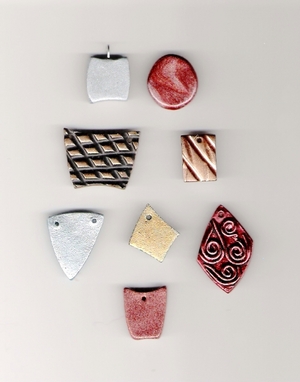Polymer clay is an adaptable medium. It can be made to resemble many different substances – including metals like gold, silver, and copper, which is very useful if you’re making jewelry. Here are some ways you can produce “faux metal” effects with polymer clay.
Use metallic clay
Some polymer clay colors are labeled “metallic.” These colors don’t contain any real metal (which is great if you’re making jewelry for someone who’s allergic to metals). Instead, they’ll have one of two additives – glitter or mica particles. The metal effect is produced by the light reflecting off the surface of these particles.
The glitter particles used in “metallic” clay are small, but they’re not very concentrated and can be seen fairly easily. That may be why I don’t personally think glitter is a good way to get a metallic effect. I work with glitter a lot myself, and I’ve noticed that when it’s mixed in clay the particles don’t always reflect light well. They will provide a lot of sparkle if you just apply them to the surface. But while I love this effect, I don’t think it looks very much like metal.
You can also buy metallic clay that contains mica particles rather than glitter. Mica is a mineral that can be ground into very small flat particles. When the flat sides are facing up they reflect light. When the particles are turned on their sides no light is reflected and the clay looks darker. This property has been used by polymer clay artists to create some spectacular effects.
If you’re using this kind of metallic clay the mica particles will automatically align themselves to the surface of the clay as you condition it. It’s easier to condition clay with a pasta machine, but if you need thicker pieces you can do it by hand; it just takes longer. When you’re finished the surface of the clay will look a bit brighter than usual. But if you’ve made a block and you cut into it you’ll see that the sides are a lot darker – because the mica particles aren’t facing that way.
This “scientific” information about how mica particles reflect light may not seem that important, and if you’re just using the flat surface of the clay it probably won’t be. But if you’ve added metallic clay to a cane – where you’ll be making crosswise cuts – the directions the particles face could make the metallic clay look randomly dark and light, and that could really change the appearance of your cane.
Treat the surface of regular clay
Mica particles are also present in two products you can apply to the surface of the clay – “metallic” craft paint and mica powders (brands like PearlEx and Perfect Pearls). Painting or applying powder to the surface is probably the best way to get your clay to look like real metal. But you can also mix the powder into the clay as you’re conditioning it, in which case you’re creating the same kind of clay as I described above – except with your own creative touch to it.
In some cases – especially if you use powders rather than paints – the color of the base clay will affect the look of the entire piece. I like to use black clay with a textured surface because if the powder or paint doesn’t get in the grooves in the surface – and I usually make sure it doesn’t – those grooves will be darker, giving the object more depth. Also, it may make the object look older – as if the color has simply worn off in places.
Depending on the object you’re making, and the amount of wear it will get, it may be a good idea to seal the surface with a varnish or glaze. If you do use a sealant remember that it may contribute to the surface effect; for example, gloss varnish will make the object shinier, which may detract from the dull metal effect you were trying for. In that case, use varnish with a matte finish instead.
Precious metals are just one kind of “faux” effect you can produce with polymer clay. But this effect is so easy to create that it’s a good starting point for other, more complex, techniques. You may even find – as I have – that some people won’t be able to tell the difference between your “faux silver” polymer clay pendant and the real thing.






